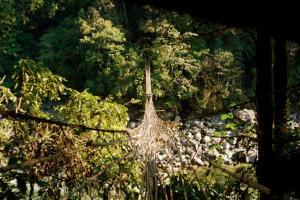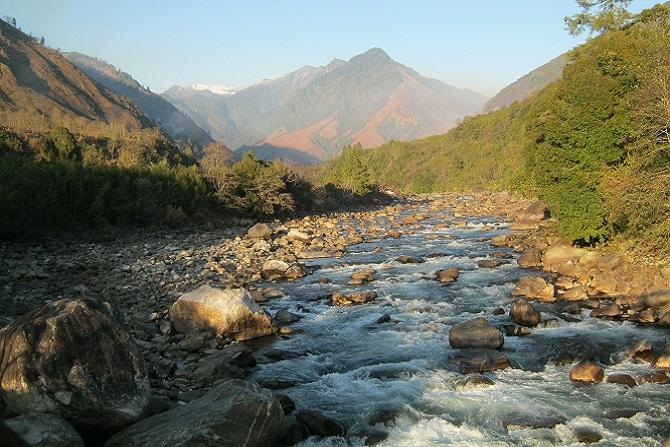Bittu Sahgal, editor, Sanctuary Asia magazine, said, "Building dams in the Himalayas, when melting of glacier has rendered river flow data unreliable and outdated, is patently artless

Dibang Valley is one of the most ecologically rich zones of the country. Pic credit/Arjun Kamdar
At a time when the pandemic is making us realise the importance of protecting the environment, the proposal for the Etalin Hydro-Electric Project (3,097 MW) in Arunachal Pradesh's Dibang Valley was placed for approval before the Forest Advisory Committee (FAC) of Ministry of Environment, Forest and Climate Change on April 23. It has not gone down well with conservationists as about 2.7 lakh trees have to be cut down to make way for the project.
ADVERTISEMENT
Speaking to mid-day, Arjun Kamdar, who is studying MSc Wildlife Biology and Conservation at National Centre for Biological Sciences, Bangalore, said, "The proposed Etalin dam is slated to be the largest hydro-project in the country, which will not only destroy the biodiversity of the region but also threaten the lives of millions of people who live downstream. Independent studies have shown that as these rivers are glacier-fed, climate change will render these projects inefficient within the next 30 years."
 Pic/Arjun Kamdar
Pic/Arjun Kamdar
Bittu Sahgal, editor, Sanctuary Asia magazine, said, "Building dams in the Himalayas, when melting of glacier has rendered river flow data unreliable and outdated, is patently artless. Besides, clearly the Standing Committee of the MoEFCC and the Forest Clearance Committee has not applied its mind to the reality that the forests they so nonchalantly, some might suggest illegally, destroy are more valuable as infrastructures in an era of accelerating climate crisis, of both survival and commerce than the dams that are at risk of becoming stranded assets even before the first turbines turn. The banks have obviously not done their risk analysis diligently. Its also time for us to question the wisdom of the MoEFCC and their choice of independent members, who have probably not understood the importance of the reports by the Intergovernmental Panel on Biodiversity and Ecosystem Services and WHO, which point to deforestation as a key factor that could lead to the next pandemic from displaced species that come into contact with humans."
Conservationist and Director of The Corbett Foundation, Kedar Gore, said, "No compensatory afforestation programme can ever replace the irreversible loss of 2.7 lakh trees. There are very few areas remaining in India with such extraordinary biodiversity wealth, much of which is endemic. It is unfortunate that such projects are being pushed through ignoring all appeals from scientists and conservationists. It is indeed shocking that the COVID-19 pandemic has still not opened the eyes of our policymakers."
It may be noted back the forest advisory committee has already discuss the issue of forest clearance for the project in the meeting that took place on April 23rd but there has no been any final decision that has been taken.
According to the plans the hydroelectric project will be coming up in dibang valley which is one of the most biodiversity Himalayan zones in Arunachal Pradesh. The project will involve diversion of 1150.08 hectares of land having rich biodiversity and it will require cutting of 2.7 lakh trees from the “subtropical evergreen broad-leaved and subtropical rainforest
When contacted, actor Dia Mirza, who is also UNEP Goodwill Ambassador and UN Secretary Generals Advocate for SDGs, said, "Humanity is experiencing firsthand the effects of biodiversity loss and wild nature from the COVID-19 pandemic. If there is one thing this human crisis must teach us to do, it will be to acknowledge the linkages between ecological balance and health. This bio-diverse region cannot and must not be devastated by this project."
Rare and important species found in the area includes
Mishmi Takin (endangered goat) , clouded leopard, tigers, himalayan serow, Asiatic bgolden cat, Sclater's monal, Mishmi wren babbler, Marbled cat and Mishmi giant flying Squirrel.
4. Herpetologist Kedar Bhide said , "Arunachal should be declared as complete eco sensitive zone with respect to it's biodiversity as well as cultural diversity . Any large ill conceived projects like hydro electric power or a highway infra projects should not be even thought in such ecological and cultural sensitive area".
Catch up on all the latest Mumbai news, crime news, current affairs, and a complete guide from food to things to do and events across Mumbai. Also download the new mid-day Android and iOS apps to get latest updates.
Mid-Day is now on Telegram. Click here to join our channel (@middayinfomedialtd) and stay updated with the latest news
 Subscribe today by clicking the link and stay updated with the latest news!" Click here!
Subscribe today by clicking the link and stay updated with the latest news!" Click here!






